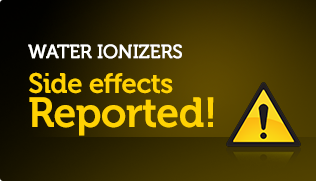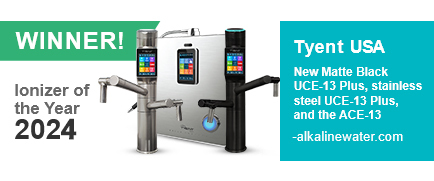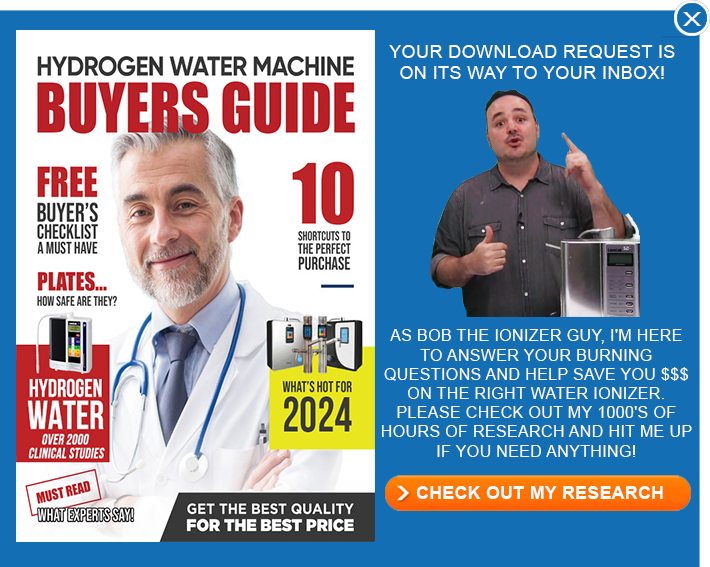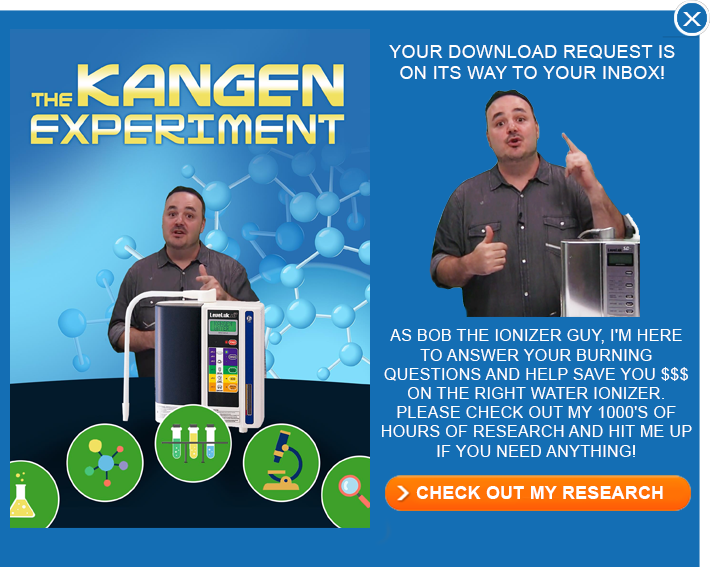Glossary of Terms for Water Ionizers
This section will help you become an expert on all the terms used regarding water ionizers.
Active (activated) CarbonActive carbon
We know this is the age old standard for removing chlorine. It is a good idea to have at least some acive carbon in your filter.
Adaptability
One of the things that boggles our mind is how a machine with a button that says 9.5 is going to be able to get 9.5 in areas that have varying source water. If you press 9.5, do you have to live in California or North Carolina to get 9.5? The solution to this problem is adjustable pH levels. We only know of one company that has addressed this challenge, but it seems like it can’t be long before others have to follow suit. It is next to impossible to get accurate pH settings without adjustable pH levels.
Biostone
This is the brain child of Jupiter and Ionways. We think it might be made up. If you do search on the internet for biostone, the only thing you will find is from water ionizer dealers. What is Biostone? We can’t find any supporting evidence that is does anything. We can’t even find evidence that it exist.
Calcium Sulphite (Sulfite)
Enagic’s filter is filled with calcium sulphite (sulfite). This stuff is extremely toxic. Do some research and see what we mean. Avoid at all cost.
Chemical Injectors
A chemical injector is a compartment inside the water ionizer that injects a chemical into the water to enhance the electrolysis of the water. Only one machine has a chemical injector. The Enagic™ machine has a chemical injector. This is the secret that Enagic doesn’t talk about. The only reason Enagic can get PH levels under 3 and over 12 is because they inject a chemical into the water. At that point its not just water anymore. We are not quite sure what exactly is in the chemical, but the bottle says “Not for Drinking” on it, so we figured that was all of the research we needed to do.
Ease of Use
We set a rating system for ease of use. The system is the same one used in high school. F being the least user friendly and A+ being the most user friendly. Look for an A or an A+, you will be glad that you did.
Filter Life – This is the amount of use that you can expect to get from a set of filters. Be careful with this one, because it is going to vary based on how many people are using it. We laugh when we see companies mention an amount of time for filter life, because it is a variable measurement based on usage, not time. Certainly go for a dual filter machine.
Filter Material
The is the material that is inside the filters. Many companies preach about their number of stages, but the real test comes from what the machines will actually remove from your water. We like filters with at least some ceramic in them . Ceramic from our research has the best performance. Most companies do not want to pay for the high cost of ceramic, but it is a great option when available. See other types of filter material below.
Flow Control
Flow control refers to the speed at which the water passes across the plates. Flow control can be either manual or electronic. With manual flow control, You must adjust the rate of water flow by hand. We found that it is nearly impossible to get consistent pH levels out of a machine with a manual flow control. Electronic flow control means that the ionizer adjusts the speed for you. Since this is done electronically, you never have to guess what PH level water you are getting. Consistent water every time. What a great idea!
Flow Rate
Flow rate refers to the speed at which the water comes out of the machine. Flow rates ranges from ¾ of a gallon per minute to over 1 gallon per minute. Some companies make it a big selling point, but we found that the extra few seconds it takes to fill up a glass is a negligible concern (to us anyway).
ORP Ratings
This is the biggest benefit to a water ionizer. ORP stands for Oxidation Reduction Potential . ORP is the measure of the machines ability to create anti oxidant properties in the water. In general, the lower the negative number, the better. Depending on your source water, your ORP ratings will vary. We have seen better than -600 in some circumstances, but it is not necessary or common. If you are getting better than -200, you are doing well.
pH Ratings
Source water plays a huge part here. The recommended drinking level is approximately 9.5. Depending on the minerals in your water, you may find that you struggle to get low acid water from your machine. This will likely be the case with any water ionizer, so don’t panic, its your source waters fault.
Plate Size
Plate size is extremely important. The longer the water stays in contact with the surface area of the plate, the more affect the plate will have on the water. This is a simple scientific fact with no explanation needed, and no room for debate. That being said, you will get the old “Our machine is more powerful so it doesn’t need large plates” along with “Technology gets smaller as time goes on” and the infamous “Our plates are superior to other plates so size isn’t important”. Don’t buy into any of it. It is simple science.
Plate Design
Mesh, Mesh, Mesh! We can’t say it enough. Mesh plates are the future of water ionizers. A solid plate will never be as good of a conductor of electricity as a plate that uses mesh technology. So many companies won’t spring for the mesh technology and tried to convince us that solid plates are better. We passed 9th grade science buddy! Again, be ready for tons of jargon as the manufacturers that don’t have mesh plates try to justify it. The latest from Enagic (Kangen) is that mesh plates can’t handle heat and that they will melt an deteriate over time. This is complete baloney!
Plate Quantity
Most machines on the market have 5 plates. There are some machines with 7 plates as well, so what does it all mean? Of course, a machine with 7 plates is a huge step above a machine with 5 plates, but it goes further than that. 7 mesh plates are proven (over and over again) to outperform 7 solid plates by about 25%, but it doesn’t stop there. Once you confirm that a machine has mesh plates, be SURE to ask about plate size. The size of the plates are extremely important. Just because a machine has 7 plates, doesn’t mean it is a good machine. We want to see good surface area, and even 1 inch when measuring plate size can play a huge role. Ask how big the plates are in the machine of your choice. It’s very important and you deserve to know what you are buying.
Power
This is a big deal! Why? Well, water ionizers do not like heat. If they get hot, they get angry. There are only two types of power sources available today. The first one is the age old transformer. It is a time tested power source, but it gets hot, and it does it fast. This means you can only use machines with transformers for a limited time before you need to give them a rest. The other method of power is called an SMPS. This is the wave of the future. More and more manufacturers are going this way, because it provides clean, cool power and it doesn’t get hot. This means no unnecessary wear the is the same power method used in high definition televisions, and no time limit on usage. One of the coolest things about the SMPS power is that it gives you the ability to adjust the power based on your soucre water. NOTE: Some higher end machines give you lots of power settings, so keep an eye out for this benefit.
Polyethylene
Some ionizer manufacturers used to put polyethylene in their filters and we were not sure what they were thinking. Do a search on google.com™ for “Polyethylene Toxic” and you will see what we mean. This link sums up why we think you should steer clear of anything with polyethylene in it.
Source Water
Source water is the water that comes out of your faucet. Source water has a great impact on your water ionzers ability to alkalize the water. A machine that puts out a 9.5 in California may only put out an 8.5 in North Carolina. This is because of the minerals that are in the source water before it even hits the machine. This is important to remember. Your water will effect your results in a big way.
The truth about trials
Go for a machine that has at least a 60 day trial. 2 months is a good amount of time to start noticing wonderful results. Enagic only offers a 3 day trial. Hmmmm!
Warranty
We have 3 words for you. “Read the warranty”. Most companies are going for the “5 year warranty” pitch, but they are not all created equal. Some are 5 years parts and service, while most are 2 or 3 years parts with a couple extra years for service. If you can find a machine that you like with a full 5 year parts and service warranty, then by all means go for it. Warranty is an important consideration and should not be taken lightly.

3 Tips to Becoming a Dealer—My Story
Ever think about selling water ionizers? Wondering if there is money to be made? The truth is...
Read More 1-877-878-7220
1-877-878-7220 











4 Responses
eric says:
does it filter out fluride?
Linda says:
what does SMPS stand for? Can this technology be used in any/every home?